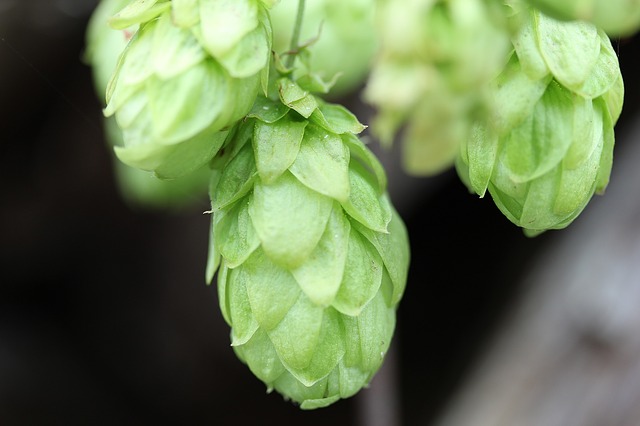 |   |  |  |  |
 |  |  |
A perennial plant of the hemp family with a winding stem. Flowers of each sex are on their own plant. The stem of the winding liana is four-sided and covered with spines.
Male flowers green to yellow. After flowering, the female flowers form a hop cone - it is rich in various valuable organic substances.
Blooms from July to August.
It is common to find this plant in backyard gardens, but it often grows in the wild, more often it takes up residence in some willow groves, where it can easily wind. It also likes deciduous forest clearings.
When it is time to harvest hop fruits, it can be determined by several characteristics:
- Monitor the condition of the cones starting from the second half of August;
- The scales of the cone should become yellowish-brownish;
- Ripe hops become a bit sticky and stick to your fingers;
- When squeezed, they quickly return to their original position;
It is important to collect hops in time and not to collect already browned cones, because they have practically lost their medicinal effect, but you can already fill pillows with them and they will have a calming effect.
Medicinal significance
Perennial creeper, which is used as a sedative.
Hops are used for insomnia, nervous overwork, increased excitement, vegetative dystonia (especially hypertonic type), hysteria, climatic disorders.
In dermatology, hops are used in seborrheic eczema, atopic dermatitis, psoriasis and hair loss.
Hops are commonly used as an ingredient in herbal blends and bioactive nutritional supplements.
Hop cones have a calming, anti-inflammatory, diuretic, antispasmodic, bactericidal effect. Substances that provide these properties are bitter substances, phenolic compounds and essential oils.
The bitter substance lipulin has a calming effect on the central nervous system. Likewise, the components of essential oils - volatile alcohols, whose concentration increases directly during the drying process, reaching a maximum after 2 years of storage - are also responsible for the sedative effect of hops. For sedative effects, hops are usually used in mixtures with valerian or some other herb.
Experiments have also determined the hypotensive and anti-cardiac arrhythmia effects of hops. Medicinal products containing hop resin have been experimentally determined to accelerate tissue regeneration, improve blood composition and activate gastric secretions.
Hop bitter substances have strong antiseptic properties. They reduce the growth rate of phytopathogenic fungi, even destroying some, reduce the growth of dermatocots, practically stop the development of gram-positive and acid-resistant and, when used in high concentrations, also gram-negative bacteria. Alpha and beta acids, which are made up of hop resin, have antibiotic properties.
Hop essential oil is also effective against gram-positive bacteria and fungi.
Hop bitter substances stimulate appetite and improve digestive processes. When using a decoction of hops, it enhances gastric secretion and evacuation properties, especially useful for patients with gastritis with reduced acid content.
Flavonoids and vitamins act as anti-ulcer and capillary strengthening elements.
Phenolic compounds of hops are strong antioxidants, chalcones and flavanones neutralize all free radicals, reduce the possibility of oxidation of free radicals, which can cause atherosclerosis, inflammation, carcinogenesis and other pathological processes.
Hops also have a beneficial effect on fat, mineral and substance exchange processes.
Hop cones have estrogenic activity. There is an assumption that it is this hormonal activity that is related to the ability to reduce male sexual arousal.
In folk medicine, the infusion, decoction and infusion are used as a sedative for the treatment of insomnia, prevention of nervous excitement, epilepsy, hysteria, neurasthenia, neuralgia, dizziness, cardioneurosis, increased sexual excitability, frequent pollution, painful erections, climatic neurosis, heart failure, vomiting, pregnancy during and for young children, seasickness, nocturnal incontinence.
As a sleeping aid, hops are used to fill pillows - especially useful when you cannot take medicine.
Water infusions from a ready hop cone are recommended to improve digestion, appetite in case of hyposecretory gastritis, gastroenteritis, gallbladder disease, infectious-toxic liver damage, viral hepatitis and jaundice.
Hop cones are used for kidney diseases, inflammation of the bladder and its pathways, and cystitis. It is also often used for flu, cough, tuberculosis and other respiratory diseases.
Folk medicine recommends using hop flowers in case of lung, stomach and liver cancer. An infusion of the leaves can be used to improve eyesight, as well as to treat prostatitis and worm infestations.
A decoction and infusion of hops is used in cases of amonorrhea, dysmenorrhea, estrogen deficiency, as well as hyperlactation or cessation of lactation.
Externally applied as compresses and ointments to treat joints, radiculitis, burns, frostbite, bruises, fungal diseases, infected wounds; bath in rheumatism and gout.
